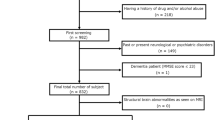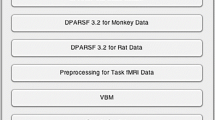Abstract
There is a growing interest in the use of functional imaging to assess brain activity in the absence of behavioural responses in patients with disorders of consciousness (DOC). In the present study, we applied a hierarchical auditory stimulation paradigm to functional magnetic resonance (fMRI) in a group of long-term DOC adult patients. Brain response to pairs of pseudowords, of unrelated words and of semantically related words, i.e. stimuli differing in lexical status (words vs. pseudowords) and semantic relatedness (related vs. unrelated) was assessed. The former contrast was considered to reflect the automatic brain response to the passive presentation of meaningful real words, while the latter aimed to assess the response to meaning relationships. The results of the study indicate that automatic lexical processing can be observed in minimally conscious state (MCS), but also in vegetative state/unresponsive wakefulness syndrome (VS/UWS) patients, as indicated by increase in blood oxygenation level dependent (BOLD) activity in the linguistic networks. DOC patients, for some task conditions, recruited additional areas in comparison to healthy participants. Furthermore this study provides additional evidence of the potential role of fMRI in the assessment of residual cognitive processing in some of these patients, which may not be evident at the clinical level.



Similar content being viewed by others
References
Barca, L., Burani, C., & Arduino, L. S. (2002). Word naming times and psycholinguistic norms for italian nouns. Behavior Research Methods, Instruments, & Computers: A Journal of the Psychonomic Society, Inc, 34(3), 424–434.
Barnett, V., & Lewis, T. (1978). Outliers in statistical data (286: 293). New York: Wiley.
Binder, J. R., Desai, R. H., Graves, W. W., & Conant, L. L. (2009). Where is the semantic system? A critical review and meta-analysis of 120 functional neuroimaging studies. Cerebral Cortex (New York, N.Y.: 1991), 19(12), 2767–2796.
Birn, R. M., Cox, R. W., & Bandettini, P. A. (2004). Experimental designs and processing strategies for fMRI studies involving overt verbal responses. NeuroImage, 23(3), 1046–1058.
Britz-Cunningham, S., & Gerbaud, V. H. (2012). Functional anatomy of the FDG image. In A case-based approach to PET/CT in oncology (pp. 53–74). Cambridge: Cambridge University Press.
Coleman, M. R., Rodd, J. M., Davis, M. H., Johnsrude, I. S., Menon, D. K., Pickard, J. D., & Owen, A. M. (2007). Do vegetative patients retain aspects of language comprehension? evidence from fMRI. Brain: A Journal of Neurology, 130(Pt 10), 2494–2507.
Coleman, M. R., Davis, M. H., Rodd, J. M., Robson, T., Ali, A., Owen, A. M., & Pickard, J. D. (2009). Towards the routine use of brain imaging to aid the clinical diagnosis of disorders of consciousness. Brain: A Journal of Neurology, 132(Pt 9), 2541–2552. doi:10.1093/brain/awp183.
Cook, R. D., & Weisberg, S. (1982). Residuals and influence in regression. New York: Chapman and Hall.
Copland, D. A., de Zubicaray, G. I., McMahon, K., Wilson, S. J., Eastburn, M., & Chenery, H. J. (2003). Brain activity during automatic semantic priming revealed by event-related functional magnetic resonance imaging. NeuroImage, 20(1), 302–310.
Crinion, J., Ashburner, J., Leff, A., Brett, M., Price, C., & Friston, K. (2007). Spatial normalization of lesioned brains: performance evaluation and impact on fMRI analyses. NeuroImage, 37(3), 866–875.
Cruse, D., Beukema, S., Chennu, S., Malins, J. G., Owen, A. M., & McRae, K. (2014). The reliability of the N400 in single subjects: implications for patients with disorders of consciousness. NeuroImage. Clinical, 4, 788–799.
Davis, M. H., Coleman, M. R., Absalom, A. R., Rodd, J. M., Johnsrude, I. S., Matta, B. F., et al. (2007). Dissociating speech perception and comprehension at reduced levels of awareness. Proceedings of the National Academy of Sciences of the United States of America, 104(41), 16032–16037.
De Mauro, T., Mancini, F., Vedovelli, M., & Voghera, M. (1993). Lessico di frequenza dell’italiano parlato. Milano: Etaslibri.
Della Rosa, P. A., Catricala, E., Vigliocco, G., & Cappa, S. F. (2010). Beyond the abstract-concrete dichotomy: mode of acquisition, concreteness, imageability, familiarity, age of acquisition, context availability, and abstractness norms for a set of 417 italian words. Behavior Research Methods, 42(4), 1042–1048.
Eickhoff, S. B., Stephan, K. E., Mohlberg, H., Grefkes, C., Fink, G. R., Amunts, K., & Zilles, K. (2005). A new SPM toolbox for combining probabilistic cytoarchitectonic maps and functional imaging data. NeuroImage, 25(4), 1325–1335.
Evans, A. C., Collins, D. L., Mills, S. R., Brown, E. D., Kelly, R. L., Peters, T. M. (1993). 3D statistical neuroanatomical models from 305 MRI volumes. Proceedings of IEEE-Nuclear Science Symposium and Medical Imaging Conference, 1813–1817.
Fernandez-Espejo, D., Junque, C., Vendrell, P., Bernabeu, M., Roig, T., Bargallo, N., & Mercader, J. M. (2008). Cerebral response to speech in vegetative and minimally conscious states after traumatic brain injury. Brain Injury, 22(11), 882–890.
Friederici, A. D. (2011). The brain basis of language processing: from structure to function. Physiological Reviews, 91(4), 1357–1392.
Friston, K. J., Frith, C. D., Turner, R., & Frackowiak, R. S. (1995a). Characterizing evoked hemodynamics with fMRI. NeuroImage, 2(2), 157–165.
Friston, K. J., Holmes, A. P., Poline, J. B., Grasby, P. J., Williams, S. C., Frackowiak, R. S., & Turner, R. (1995b). Analysis of fMRI time-series revisited. NeuroImage, 2(1), 45–53.
Geukes, S., Huster, R. J., Wollbrink, A., Junghofer, M., Zwitserlood, P., & Dobel, C. (2013). A large N400 but no BOLD effect--comparing source activations of semantic priming in simultaneous EEG-fMRI. PloS One, 8(12).
Giacino, J. T., Zasler, N. D., Katz, D. I., Kelly, J. P., Rosenberg, J. H., & Filley, C. M. (1997). Development of practice guidelines for assessment and management of the vegetative and minimally conscious states. The Journal of Head Trauma Rehabilitation, 12(4), 79–89.
Giacino, J. T., Ashwal, S., Childs, N., Cranford, R., Jennett, B., Katz, D. I., et al. (2002). The minimally conscious state: definition and diagnostic criteria. Neurology, 58(3), 349–353.
Giacino, J. T., Kalmar, K., & Whyte, J. (2004). The JFK coma recovery scale-revised: Measurement characteristics and diagnostic utility. Archives of Physical Medicine and Rehabilitation, 85(12), 2020–2029.
Giacino, J. T., Fins, J. J., Laureys, S., & Schiff, N. D. (2014). Disorders of consciousness after acquired brain injury: the state of the science. Nature Reviews. Neurology, 10(2), 99–114.
Gosseries, O., Di, H., Laureys, S., & Boly, M. (2014). Measuring consciousness in severely damaged brains. Annual Review of Neuroscience, 37, 457–478.
Harrison, A. H., & Connolly, J. F. (2013). Finding a way in: a review and practical evaluation of fMRI and EEG for detection and assessment in disorders of consciousness. Neuroscience and Biobehavioral Reviews, 37(8), 1403–1419.
Holm, S. (1979). A simple sequentially rejective multiple test procedure. Scandinavian Journal of Statistics, 6(2), 65–70.
Kotz, S. A., Cappa, S. F., von Cramon, D. Y., & Friederici, A. D. (2002). Modulation of the lexical-semantic network by auditory semantic priming: an event-related functional MRI study. NeuroImage, 17(4), 1761–1772.
Kotz, S. A., D’Ausilio, A., Raettig, T., Begliomini, C., Craighero, L., Fabbri-Destro, M., et al. (2010). Lexicality drives audio-motor transformations in Broca’s area. Brain and Language, 112(1), 3–11.
Laureys, S., Celesia, G. G., Cohadon, F., Lavrijsen, J., Leon-Carrion, J., Sannita, W. G., et al. (2010). Unresponsive wakefulness syndrome: a new name for the vegetative state or apallic syndrome. BMC Medicine, 8, 68.
McNamara, T. P. (2005). Semantic priming: Perspectives from memory and word recognition. New York: Psychology Press.
Morosan, P., Rademacher, J., Schleicher, A., Amunts, K., Schormann, T., & Zilles, K. (2001). Human primary auditory cortex: cytoarchitectonic subdivisions and mapping into a spatial reference system. NeuroImage, 13(4), 684–701.
Nieto-Castanon, A., Ghosh, S. S., Tourville, J. A., & Guenther, F. H. (2003). Region of interest based analysis of functional imaging data. NeuroImage, 19(4), 1303–1316.
Owen, A. M., Coleman, M. R., Menon, D. K., Johnsrude, I. S., Rodd, J. M., Davis, M. H., et al. (2005). Residual auditory function in persistent vegetative state: a combined PET and fMRI study. Neuropsychological Rehabilitation, 15(3–4), 290–306.
Peressotti, F., Pesciarelli, F., & Job, R. (2002). Le associazioni verbali PD/DPSS: norme per 294 parole. Giornale Italiano di Psicologia, 29(1), 153–170.
Power, J. D., Barnes, K. A., Snyder, A. Z., Schlaggar, B. L., & Petersen, S. E. (2012). Spurious but systematic correlations in functional connectivity MRI networks arise from subject motion. NeuroImage, 59(3), 2142–2154.
Price, C. J. (2012). A review and synthesis of the first 20 years of PET and fMRI studies of heard speech, spoken language and reading. NeuroImage, 62(2), 816–847.
Rohaut, B., Faugeras, F., Chausson, N., King, J. R., Karoui, I. E., Cohen, L., & Naccache, L. (2015). Probing ERP correlates of verbal semantic processing in patients with impaired consciousness. Neuropsychologia, 66, 279–292.
Rousseau, M. C., Confort-Gouny, S., Catala, A., Graperon, J., Blaya, J., Soulier, E., et al. (2008). A MRS-MRI-fMRI exploration of the brain. Impact of long-lasting persistent vegetative state. Brain Injury, 22(2), 123–134.
Sachs, O., Weis, S., Zellagui, N., Huber, W., Zvyagintsev, M., Mathiak, K., & Kircher, T. (2008). Automatic processing of semantic relations in fMRI: neural activation during semantic priming of taxonomic and thematic categories. Brain Research, 1218, 194–205.
Sachs, O., Weis, S., Zellagui, N., Sass, K., Huber, W., Zvyagintsev, M., et al. (2011). How different types of conceptual relations modulate brain activation during semantic priming. Journal of Cognitive Neuroscience, 23(5), 1263–1273.
Schiff, N. D., Rodriguez-Moreno, D., Kamal, A., Kim, K. H., Giacino, J. T., Plum, F., & Hirsch, J. (2005). fMRI reveals large-scale network activation in minimally conscious patients. Neurology, 64(3), 514–523.
Siegel, J. S., Power, J. D., Dubis, J. W., Vogel, A. C., Church, J. A., Schlaggar, B. L., & Petersen, S. E. (2014). Statistical improvements in functional magnetic resonance imaging analyses produced by censoring high-motion data points. Human Brain Mapping, 35(5), 1981–1996.
Vul, E., & Pashler, H. (2012). Voodoo and circularity errors. NeuroImage, 62(2), 945–948.
Acknowledgments
The Besta Coma Research Centre (CRC) team, on behalf of which the present publication was submitted, would like to acknowledge its other members: A. Andronache, P. Fazio, D. Caldiroli, F. Ciaraffa, V. Covelli, A. Giovannetti, L. Minati, F. Molteni, M. Pagani, F. Panzica, E.A. Parati, B. Reggiori, C. Rosazza, G. Varotto, J. Vela Gomez, and E. Visani. The study was realized in collaboration with the European Biomedical Research Federation (FERB). The authors are grateful to Prof. Sonja Kotz, Laura Verga, and Pasquale Della Rosa for support and insights during task implementation and to Francesca Epifani for assistance during data acquisition.
Author information
Authors and Affiliations
Consortia
Corresponding author
Ethics declarations
Funding
This study was funded by Regione Lombardia (IX/000407-05/08/2010 to M.L.).
Conflict of interest
Author A.N. declares that she has no conflict of interest. Author E.C. declares that she has no conflict of interest. Author S.F. declares that she has no conflict of interest. Author M.G.B. declares that she has no conflict of interest. Author L.D. declares that he has no conflict of interest. Author D.S. declares that he has no conflict of interest. Author D.R.S. declares that he has no conflict of interest. Author S.F. declares that she has no conflict of interest. Author G.M. declares that he has no conflict of interest. Author R.B. declares that he has no conflict of interest. Author M.L. declares that she has no conflict of interest. Author S.F.C. declares that he has no conflict of interest.
Ethical approval
All procedures performed in studies involving human participants were in accordance with the ethical standards of the institutional and national research committee and with the 1964 Helsinki declaration and its later amendments or comparable ethical standards.
This article does not contain any studies with animals performed by any of the authors.
Informed consent
Informed consent was obtained from all individual participants or from the legally authorized representative of the patients included in the study.
Electronic supplementary material
ESM 1
(DOCX 808 kb)
Rights and permissions
About this article
Cite this article
Nigri, A., Catricalà, E., Ferraro, S. et al. The neural correlates of lexical processing in disorders of consciousness. Brain Imaging and Behavior 11, 1526–1537 (2017). https://doi.org/10.1007/s11682-016-9613-7
Published:
Issue Date:
DOI: https://doi.org/10.1007/s11682-016-9613-7




